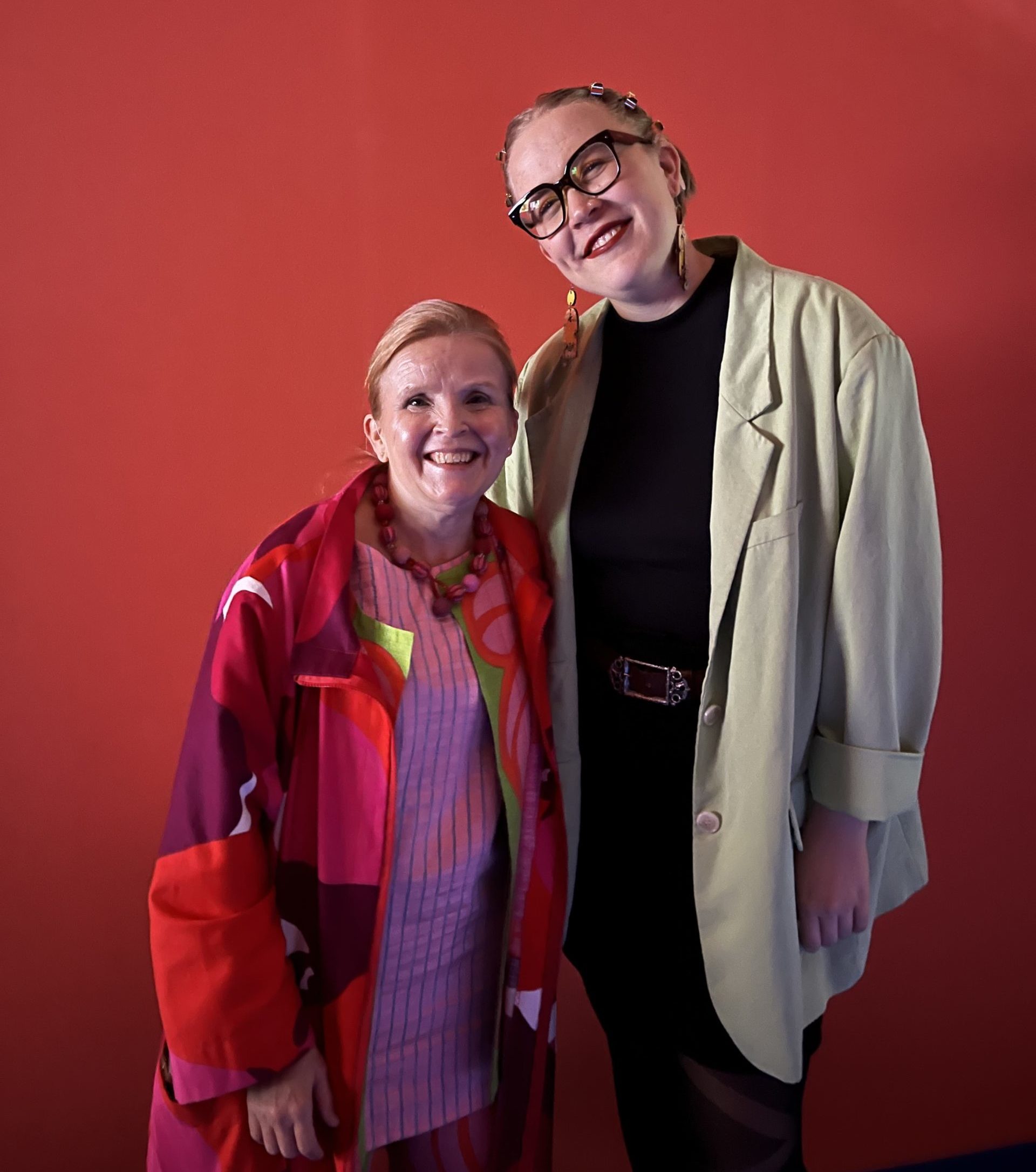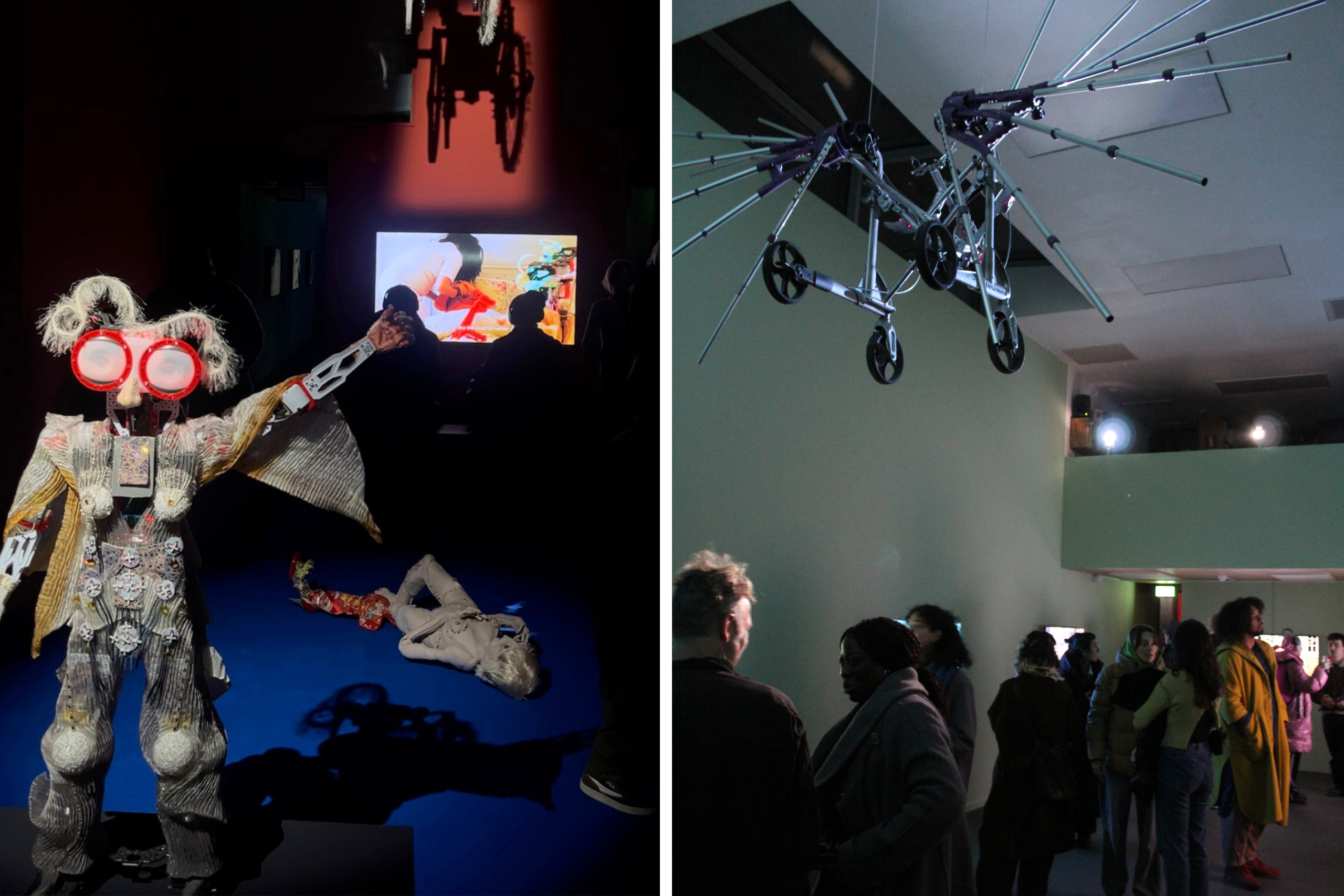Our Communications Assistant, Maija Lindström, shares her reflections on the opening of Jenni-Juulia Wallinheimo-Heimonen’s exhibition and the need for more spaces centering Disabled voices in this insightful blog post.
Radical visibility: The power of disability art
Jenni-Juulia Wallinheimo-Heimonen’s The Hague exhibition When I grow up, I will become a coat rack was nothing short of revolutionary for me as a Disabled viewer. It was one of the first times that I saw Disabled art displayed in a mainstream setting, and certainly the first time that the audience of the exhibition was largely able-bodied (or so I assume). Previously, I have attended disability-focused performances and exhibitions mostly within my own Deaf community. In these spaces, the audience has typically consisted of people who are either part of the community or closely connected to it.
Mixed emotions were present during the exhibition opening—I felt empowered, happy, and ecstatic, while also wishing there had been a larger Disabled audience at the opening. What felt absurd about this was that, in my 24 years, I had never seen so many non-disabled people enthusiastically engaging with unapologetically Disabled art. What a concept!
Upon entering the exhibition, the first thing I saw was Jenni-Juulia giving a presentation to a crowd of cultural professionals. A sight so rare that it felt unfamiliar— a Disabled artist presenting her work to an audience of professional, able-bodied viewers. Revolutionary! How I wish this were more common and that more Disabled artists had opportunities to present their work in similar settings.
Topics like war and world politics are frequently addressed in mainstream exhibitions, but why is disability—a subject deeply intertwined with both—often overlooked? The Disabled experience is central to conversations about economic inequality, healthcare and human rights. Yet, disability is rarely framed as an essential social issue in the same way that other marginalised identities are. Where are those stories?
Disrupting the narrative: disability as more than pity or inspiration
Walking through the exhibition surrounded by able-bodied people reminded me of two truths that are often revolutionary for non-disabled people but common sense for Disabled people:
- “Disabled” is not a dirty word.
- Disability is sexy.
The happy, comedic, and playful characters in this exhibition challenged the usual portrayals of disability as either tragic or inspirational. Instead, the artwork played with the audience’s expectations. Perhaps some viewers initially felt pity or inspiration, but then they saw Disabled characters in control: strong, rebellious, even throwing food and middle fingers at doctors. For me, watching this was almost cathartic, a release of years of collective medical trauma experienced by the disability community. For an able-bodied audience, it may have been shocking, disrupting the usual narratives they are accustomed to.
My favourite piece in the exhibition was a video from the series How Great is Your Darkness? which portrayed a group of women with different disabilities celebrating, throwing cake and food at doctors and drawing with red lipstick on their white coats. In one scene, a woman plays with a champagne glass as a stethoscope, staining a doctor’s coat. The women are seen celebrating in the sun, wearing colorful dresses, waving their white canes and hands in the air. Backed by a grand, Hollywood-style soundtrack from Kemal Gorey, it made me smile with its boldness and sense of rebellious joy.
Who gets to reflect? The need for Disabled viewpoints
As a Disabled audience member in a sea of able-bodied viewers, I found myself wondering what the other viewers were thinking.
As a Disabled audience member in a sea of able-bodied viewers, I found myself wondering what the other viewers were thinking. I yearned for an exchange of thoughts with other Disabled viewers. Coming from the Deaf community, where most people don’t consider themselves Disabled but rather part of a cultural and linguistic minority, I was curious: Would my Deaf friends see the exhibition the same way I did? Would they find it empowering, or would it feel far removed from the Deaf experience? What would my BIPOC Disabled or Deaf friends think—given that all the characters in the exhibition were white?
The exhibition spanned multiple different contexts within the disability community, managing to show many different experiences. Yet, with our community making up 16% of the world’s population, no single exhibition can fully represent the vastness of our experiences. Still, Jenni-Juulia’s sharp critique through humour was empowering. It felt satisfying to watch a typically hipster, able-bodied audience engage with a disability-focused exhibition—a theme largely ignored by this group. I’m hoping for many more exhibitions to come, and for a variety of Disabled voices to be heard in the future, as well.
Radical accessibility: What comes next?
Jenni-Juulia’s speech during the opening dinner was particularly timely. She said: “In today’s world, in the midst of all the wars, there are more and more Disabled people who are going to need services and accommodations.” The weight of our world wars today is not only a mass tragedy, but makes the Disabled community wonder about the aftermath. What happens to all those injured, those who lost limbs, their hearing or sight, or become wheelchair users? What are their conditions and stories going to be like? Is it one of tragedy or one of transformation? When there are masses and masses of a population that become Disabled, it offers us a chance to rethink accommodations to guarantee a happy and successful life for newly Disabled people.
There is a quote in the disability community that goes: “you are only temporarily able-bodied.”
The topic of disability and disability politics is one that is urgent in all of our lives. It differs from many other marginalised identities in the sense that it is largely universal, and can affect any of us; regardless of class, gender, race, and location in the world. There is a quote in the disability that goes “you are only temporarily able-bodied,” by accessibility educator Cindy Li. I dream of a world where we take this understanding seriously, and put it into practice. What could radical accessibility look like in the future?
Dreaming on!

Maija Lindström (she/her) is the Institute’s new Communications Assistant. She has been involved with disability-related organisations since childhood and is part of the Deaf community. Her favorite disability icons are Chella Man and Christine Sun Kim, both Deaf artists. Her top social media educators on Deafness are Socially Sound and Saved by the Sign. She is currently reading Disability Visibility by Alice Wong, and highly recommends it to her friends.
Practical Info:
Jenni-Juulia Wallinheimo-Heimonen
When I grow up, I will become a coat rack
7.2.2025 – 13.4.2025
1646 is located in the centre of The Hague.
Boekhorststraat 125
2512 CN The Hague
The Netherlands
Tel: +31 70 212 58 60
This exhibition takes place at 1646, an art space in the heart of The Hague and is supported by the Finnish Cultural Institute for the Benelux and the Alfred Kordelin Foundation.
Presented in collaboration with the Finnish Cultural Institute for the Benelux, the exhibition is part of the pARTir initiative funded by the European Union – NextGenerationEU programme.
PARTir is a collaborative initiative of the Finnish cultural and academic institutes aimed at creating a cultural roadmap towards responsible international mobility.

